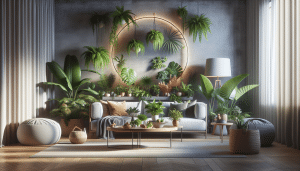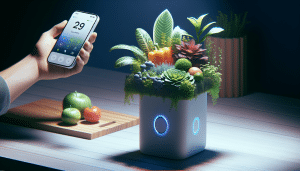You Can Start a Thriving Indoor Herb Garden
Henry King October 13, 2025
An indoor herb garden brightens spaces and brings fresh flavors right to your kitchen. This practical guide explores how you can grow herbs indoors easily, care for them successfully, and maximize harvest year-round—even in small spaces. Discover inspiring ideas, common mistakes to avoid, and what really works for long-lasting results.
Why Indoor Herb Gardens Are Worth Trying
Indoor herb gardens offer countless benefits that extend far beyond the aesthetics of having green foliage on your windowsill. When you grow herbs indoors, you enjoy easy access to fresh flavors for cooking, with no need to dash out to the store last minute. This enhances meals and inspires creativity in the kitchen. Additionally, indoor herb gardens can positively impact air quality, as certain herbs are known to help filter the air naturally. Basil, mint, and parsley all contribute to a healthier home environment while adding visual appeal and a calming touch to your interior design. The therapeutic nature of caring for plants has also been shown to reduce stress and elevate mood, providing another reason these small green additions are gaining in popularity among home gardeners. (Source: https://hgic.clemson.edu/factsheet/growing-indoor-herbs/)
Space limitations or harsh outdoor climates can make traditional gardening hard, yet even a small apartment can accommodate a thriving indoor herb garden. These gardens are versatile and fit various lifestyles, whether you’re dealing with a tiny kitchen or an urban loft. Many people find the convenience contributes to healthier eating because fresh herbs are always within reach for quick garnishes and flavorful teas. Plus, growing herbs indoors gives you year-round harvest potential, unaffected by frost or unpredictable weather patterns. With proper lighting, you can grow an impressive variety even in challenging locations, making indoor gardening a smart solution for a busy home. (Source: https://extension.psu.edu/growing-herbs-indoors)
Not only do indoor herb gardens provide functional perks, but they can serve as a project for learning and sharing across generations. Children, families, and friends can nurture seeds, observe growth, and celebrate the satisfaction of a harvest together. This hands-on experience offers valuable lessons about sustainability and plant cycles, encouraging eco-friendly choices over time. Indoor herb gardening is flexible, approachable, and can easily be scaled up or down to suit individual goals. Whether grown in pots on a countertop or a hydroponic system near a sunny window, this is a hobby anyone can explore. (Source: https://www.gardeners.com/how-to/growing-herbs-indoors/5492.html)
Getting Started: Choosing the Right Herbs
Selecting the best herbs for indoor gardens is all about matching your lifestyle, light levels, and culinary preferences. Hardy herbs like basil, chives, parsley, mint, thyme, and oregano are popular choices because they’re relatively easy to grow indoors. These herbs tolerate container environments well and adapt to varied humidity and temperature conditions indoors. If your kitchen window gets at least four to six hours of sunlight, many classic herbs will thrive, bringing delicious accents and aromas to your meals. Think about your favorite recipes and start with herbs you use most often—this keeps you motivated and makes harvesting more rewarding. (Source: https://www.motherearthnews.com/organic-gardening/growing-herbs-indoors-zbcz1401/)
For less sunny homes, consider shade-tolerant options like mint, chervil, or parsley. These herbs can thrive in indirect light or with supplemental grow lights. Compact varieties—such as dwarf basil or curly parsley—work especially well for small windowsills or countertop arrangements. Hydroponic herb kits and self-watering planters also help ensure roots receive steady moisture, making maintenance simpler for beginners. Assessing your available space and light will influence your initial herb selections, so observe your home’s layout before purchasing seeds or starter plants. (Source: https://extension.umn.edu/herb-gardening/growing-herbs-indoors)
Think seasonally. Some herbs, such as basil and cilantro, often flourish in higher winter light or under advanced LED grow lights, while others—like rosemary or sage—are more slow-growing but resilient throughout the year. Mix and match for a blend of textures, scents, and flavors. Planning ahead lets your indoor herb garden complement your cooking habits and helps prevent the disappointment of attempting to grow light-hungry herbs in a dimly lit space. For those interested in expanding, don’t hesitate to experiment with new varieties as your confidence and green thumb grow.
Planting and Potting: Laying the Foundation for Success
Plant health begins with good soil and container choice. Use high-quality, well-draining potting mixes designed for container herbs. Steer clear of heavy garden soil; it’s too dense and can suffocate roots or cause rot inside small pots. Containers should have drainage holes to help excess water escape, reducing the risk of soggy roots—a common cause of herb demise indoors. Choose pots about six inches in diameter for most herbs, leaving room for roots to develop but preventing overwatering caused by too-large containers. Terracotta, ceramic, or well-ventilated plastic pots balance moisture and airflow effectively. (Source: https://www.rhs.org.uk/plants/popular/herbs/indoor-gardening)
Careful planting is the next step. Transplant herbs gently, disturbing roots as little as possible. Fill the pot halfway with moist soil, place the herb’s root ball, and top up with soil. Water thoroughly until water drains from the holes. Grouping herbs with similar needs is a smart strategy; basil and parsley thrive in consistently moist soil, while rosemary and oregano do better when the surface dries slightly between waterings. Labeling pots at planting time saves confusion once sprouts are growing. Organizing your herb garden right from the start helps establish healthy, uniform plants that are easier to care for.
Proper spacing ensures robust growth and airflow. Overcrowding causes herbs to compete for light, nutrients, and water—resulting in weaker stems and higher risk of disease. If in doubt, grow fewer plants with more space to let them mature fully. For ambitious gardeners, vertical herb gardens or window-mounted planters can maximize available light and space. These creative options turn a bare wall or window into a practical and decorative feature, bringing the joy of gardening into every nook of the home. (Source: https://www.gardeningknowhow.com/edible/herbs/hgen/grow-herbs-indoors.htm)
Caring for Indoor Herbs: Watering, Light, and Pruning Tips
Herbs grown indoors need consistent but careful watering. Most common mistakes come from overwatering rather than neglect. Allow the top inch of soil to dry before rewatering, and empty trays beneath pots to avoid soggy roots. Mint, parsley, and basil enjoy more consistent moisture, while Mediterranean herbs appreciate drying out a bit between waterings. Each plant’s watering needs can fluctuate with changes in sunlight and indoor air temperature, so check soil moisture often instead of sticking to a set schedule. (Source: https://extension.illinois.edu/herbs/growing-herbs-indoors)
Light is another crucial factor. Most herbs grow best with at least six hours of bright, indirect sunlight daily, so place them near south- or west-facing windows whenever possible. For darker rooms or winter months, supplement with grow lights—especially broad-spectrum LEDs—positioned 6–12 inches above the plants for optimal results. Rotate pots every week or two to keep herbs growing straight and lush. If leaves appear pale or stems stretch toward light, this signals the need for additional light—adjust windowsills or bring in lights as needed to keep herbs healthy and productive.
Pruning promotes bushier, stronger plants. Regular snipping encourages new growth, plus gives you a steady supply of fresh herbs for cooking. For best results, use clean scissors and cut stems just above a pair of leaf nodes. Remove yellowing or damaged leaves right away to prevent disease or pest issues. Harvest lightly from each plant at first; once established, bolder pruning won’t harm healthy roots. Keep watch for fungus gnats or aphids and treat issues early with natural remedies or gentle soap sprays suited for edible plants.
Creative Planting Ideas for Small or Unique Spaces
Limited space need not stop you from enjoying homegrown flavor. Hanging herb planters, wall-mounted shelves, and magnetic jars can transform overlooked kitchen corners or windowsills into productive mini-gardens. Repurposed teacups or mason jars offer whimsical, decorative containers for smaller herbs. Freestanding vertical planters or stackable systems enable ambitious gardeners to fit numerous types in a footprint barely wider than a flower pot. Window boxes or railing planters expand options for balconies or fire escapes, increasing sunlight exposure and airflow. (Source: https://www.bhg.com/gardening/houseplants/projects/indoor-herb-gardens/)
Kitchens, bathrooms, or bedrooms with good natural light can all serve as herb-growing spots. Creative gardeners often install tension rods, curtain rods, or suction-cup hanging racks in window frames to maximize available sunshine for small pots. Hydroponic herb gardens—where water and nutrients replace soil—are especially effective in apartments or busy households, as they’re tidy and require little day-to-day care. Explore compact designs or modular kits tailored for countertop use; these make fresh herbs accessible even for those with hectic schedules.
Integrate herbs with other houseplants, too—mixing rosemary or lavender with decorative foliage can yield striking visual combinations. Companion planting isn’t limited to outdoor gardens; indoors, it can support pest control or promote robust growth. The key is ensuring each plant’s needs are met while sharing a common space. Grouping herbs by moisture or light preference, not just by looks, keeps maintenance simple and plants thriving together.
Avoiding Common Mistakes and Solving Challenges
Overwatering is the most frequent cause of failure for indoor herb gardens. Using pots with drain holes, light soil mixes, and watering only when the topsoil is dry prevents root rot and fungal diseases. Too little sunlight leads to leggy growth and diminished aroma, so maximize exposure or invest in energy-efficient grow lights as needed. Monitor house temperature—herbs thrive best between 60–75°F and may struggle near drafty doors or radiators. (Source: https://ag.umass.edu/home-lawn-garden/fact-sheets/herb-gardening-indoors)
Pests such as aphids or spider mites are less common indoors but can still appear. Inspect herbs weekly, especially under leaves and near stems. Remove visible critters with a damp cloth or use HEPA-filtered vacuums for stubborn infestations. Avoid harsh pesticides indoors. Instead, look for neem oil or safe organic remedies formulated for edible plants. Prompt response keeps outbreaks from spreading and protects your harvest from contamination.
Don’t forget nutrition. While most potting mixes come pre-fertilized, nutrients dwindle over time. An organic liquid fertilizer applied every three to six weeks keeps growth strong, especially when herbs are being clipped regularly. Avoid high-nitrogen mixes that may encourage too much leafy growth and weak flavor. Steady, balanced feeding helps maintain productivity and ensures your indoor garden stays lush for months—or even years—without interruption.
References
1. Clemson Cooperative Extension. (n.d.). Growing Herbs Indoors. Retrieved from https://hgic.clemson.edu/factsheet/growing-indoor-herbs/
2. Penn State Extension. (n.d.). Growing Herbs Indoors. Retrieved from https://extension.psu.edu/growing-herbs-indoors
3. Mother Earth News. (n.d.). Growing Herbs Indoors. Retrieved from https://www.motherearthnews.com/organic-gardening/growing-herbs-indoors-zbcz1401/
4. University of Minnesota Extension. (n.d.). Growing Herbs Indoors. Retrieved from https://extension.umn.edu/herb-gardening/growing-herbs-indoors
5. Royal Horticultural Society. (n.d.). Grow Herbs Indoors. Retrieved from https://www.rhs.org.uk/plants/popular/herbs/indoor-gardening
6. University of Illinois Extension. (n.d.). Growing Herbs Indoors. Retrieved from https://extension.illinois.edu/herbs/growing-herbs-indoors







